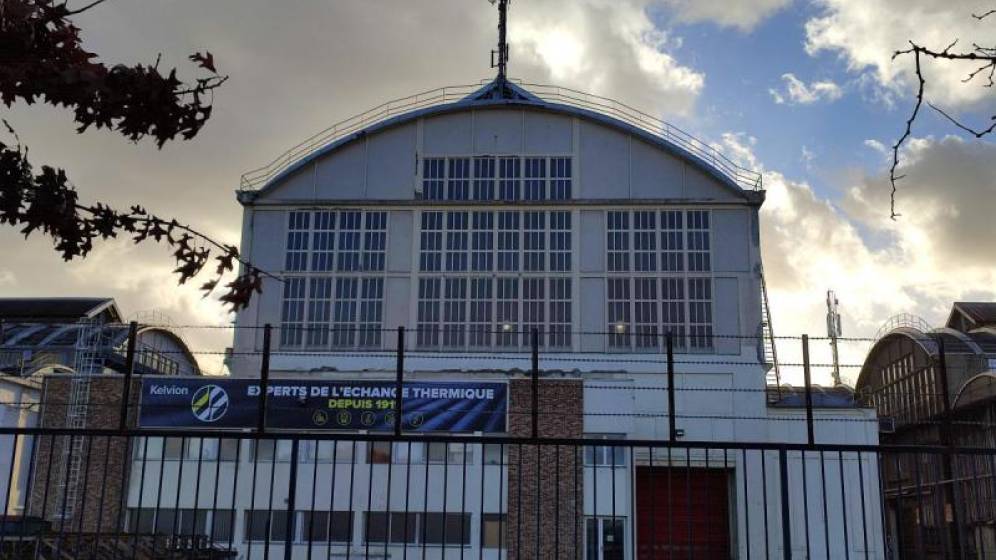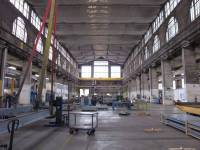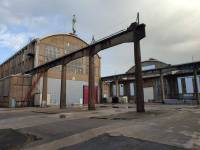L’usine des Batignolles doit son nom à une de ses sociétés mères, la SCB, Société de Construction des Batignolles, installée à l’époque dans le quartier du même nom à Paris. Trop à l’étroit dans ses locaux parisiens, souhaitant développer la construction de locomotives, et originaire de Nantes, la famille Gouïn, détentrice de la SCB, s’est associée à la Compagnie des forges de Châtillon-Commentry et de Neuves-Maisons pour confier aux entrepreneurs François Mercier et Claude Limousin la construction d’une usine, entre Nantes et Saint Joseph de Porterie, au bois Saint Georges. L’usine des Batignolles, à Nantes, a été inscrite au titre des monuments historiques le 3 août 2022. Il s’agit de la première usine nantaise et du premier ensemble industriel des Pays de la Loire, encore partiellement en activité, à bénéficier d’une protection au titre des monuments historiques. Auparavant, au début des années 2000, trois nefs avaient reçu le label Patrimoine du XXe siècle (devenu Architecture contemporaine remar-quable).
Un bâtiment avec une forte identité industrielle, urbaine et ouvrière
Cette usine a été commandée par la famille Gouïn et construite en béton armé de 1918 à 1920 par les célèbres entrepreneurs Mercier & Limousin, vraisemblablement sous le contrôle d’Eugène Freyssinet, à l’époque Directeur Technique de Mercier & Limousin, et aujourd’hui ingénieur mondialement connu. Organisée de façon rationnelle, liée presque exclusivement à l’industrie ferroviaire pendant 30 ans elle a diversifié ses activités dès après la seconde guerre mondiale, tout en conservant une fidélité d’usage dans le domaine de l’industrie, notamment vers :
- les tourelles de chars
- les tubes lance-torpilles,
- les chariots élévateurs,
- les tracteurs forestiers,
- les pompes centrifuges,
- les rotatives d’imprimerie,
- les échangeurs de chaleur pour les industries pétrolières et gazières.
En 1985, à la faillite du groupe Creusot Loire devenu propriétaire de l’ensemble, le site a été découpé en trois partie, Worhington conservant l’activité pompes centrifuges, Rockwell les rotatives d’imprimerie, et Batignolles Technologies Thermiques les échanges de chaleur .
Aujourd’hui, Batignolles Technologies Thermique, devenue en 1995 Kelvion Thermal Solution perpétue cette tradition industrielle, fabrique toujours des échangeurs de chaleur, mais accompagne chaque jour un peu plus la transition écologique, en devenant notamment un acteur majeur de la distribution de l’hydrogène.
Les Batignolles revêtent une forte identité industrielle, urbaine et ouvrière. Elles présentent un intérêt historique et architectural indéniable ainsi que des qualités esthétiques désormais reconnues par l’Etat. Cette reconnaissance régalienne s’est faite en concertation avec Nantes Métropole, les associations qui ont sollicité cette protection (le Collectif des associations du patrimoine industriel et portuaire, et Batignolles-Retrouvailles), ainsi que les propriétaires – exploitants du site.
Ont été protégés : dix nefs en béton armé, le monument aux morts dédié aux ouvriers batignollais décédés pendant la Seconde Guerre mondiale (l’usine, bombardée en 1943 et 1944, a été restaurée et reconstituée par l’architecte Charles Friésé) le pont roulant a Cremona de la plus grande nef et des portiques. L’Etat a également pris en compte les bâtiments couverts en sheds et le centre de documentation et d’information de l’usine (ancienne infirmerie), conçu par l’architecte Lucien Bechmann.
L’inscription au titre des monuments historiques
La protection au titre des monuments historiques est une servitude d’utilité publique fondée sur l’intérêt patrimonial d’un bien, qui s’évalue en examinant un ensemble de critères historiques, artistiques, scientifiques et techniques. Les notions de rareté, d’exemplarité, d’authenticité et d’intégrité des biens sont notamment prises en compte. Afin d'en assurer la conservation, la restauration et la mise en valeur, un immeuble ou un objet mobilier peuvent être protégés au titre des monuments historiques.
Il existe deux niveaux de protection au titre des monuments historiques : l'inscription et le classement. L'inscription constitue le premier niveau de protection, et le classement le niveau le plus élevé.
Les patrimoines traditionnels (églises et châteaux pour ce qui concerne les immeubles, œuvres d'art et mobilier ancien pour ce qui concerne les objets mobiliers) continuent de former la majorité des biens protégés chaque année. Toutefois, une augmentation sensible des catégories de biens protégés a eu lieu depuis les années 1970 : jardins, immeubles et objets mobiliers des XIXe et XXe siècles, patrimoine industriel, scientifique et technique (usines, bâtiments et ouvrages d’art ferroviaires, bateaux, trains, avions ou automobiles, collections scientifiques) occupent désormais une place non négligeable parmi les biens classés et inscrits.
Partager la page



